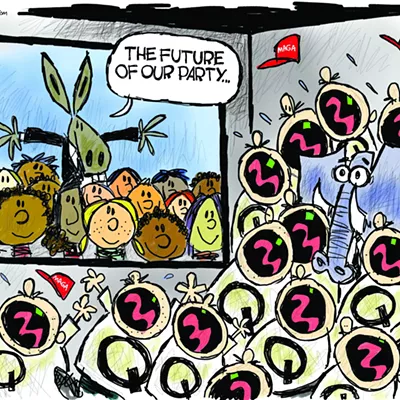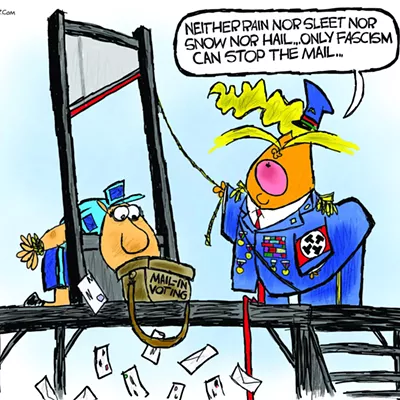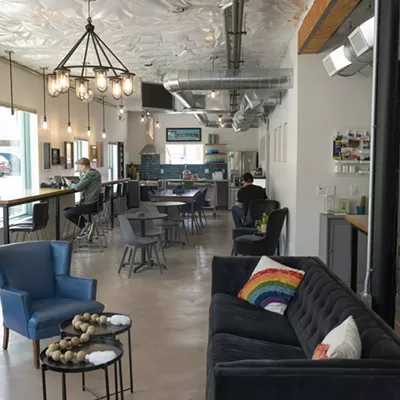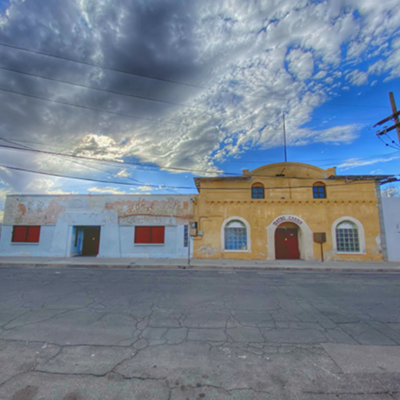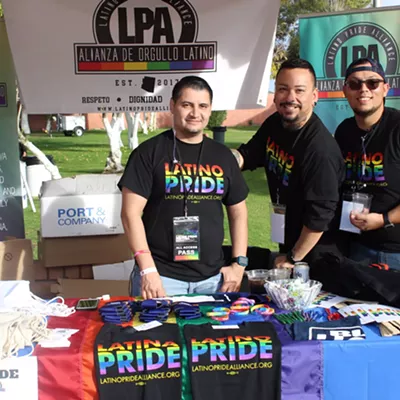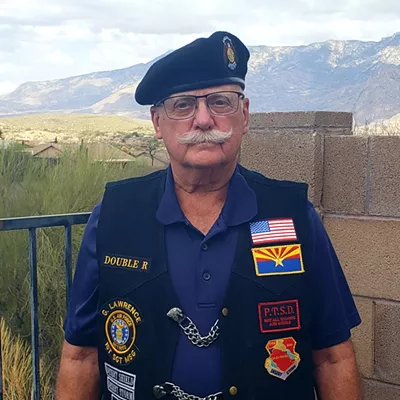Vote Yes
YES. HELL YES.That's how you ought to vote on Props 200 and 201--right now if you've got your ballot at home, or on Nov. 4 when you go to the polls.
Hey, this plan ain't perfect--but it's probably the best we're ever going to see, if the history of what we've been offered by our "civic leaders" is any indication.
In political shorthand, this plan has been reduced to the "light-rail initiative"--but it offers a lot more than that.
Start with our crumbling residential streets, which have been horribly neglected for more than a decade because the city doesn't have enough money to fix 'em. This plan spends 20 cents of every new dollar rebuilding them across our town.
Then the next big chunk: 40 percent to immediately get a better bus system on our streets. Like our streets, Sun Tran has been miserably neglected and abused for too long, resulting in a system that's so far from user-friendly that it's carrying fewer riders now than it did in the mid-'90s.
In survey after survey, the citizens of Tucson have repeatedly stressed their desire for a better bus system--maybe because many of us have came here from parts of the country where buses actually work. Or maybe it's because we have a graying population that would like an alternative to getting behind the wheel or becoming a shut-in. Or maybe it's because we're tired of driving the kids everywhere they want to go.
Well, here's your opportunity to get shorter waits and more routes--but if you don't support it now, you're not going to get another chance anytime soon.
There are other worthy elements of the plan--more traffic enforcement to ticket yahoo drivers; a financial boost for VanTran's program to help disabled folks get around town; extension of the downtown trolley all the way to Rio Nuevo.
But the big centerpiece is those two light-rail tracks, running down Broadway Boulevard and South Sixth Avenue. These are two corridors that already have the highest bus ridership, so there's a built-in customer base.
The light-rail system requires about 22 percent of the revenues raised by the plan. Supporters of the prop say that construction could begin in 2010 and the system could be carrying riders by 2012 if we get started now.
This is all about the future, folks. Gas prices are climbing high, and they're not going to drop back down. More and more people are going to move here and jam up our streets. A decade from now, we're going to need an alternative to getting in our cars every morning.
Sure, the props count on federal dollars that might not be there when it comes time to lay the track. But why not try to grab those dollars? If it doesn't work out, we can decide down the line if we want to go it alone--or return to the ballot to find another use for that money. In the meantime, at least our neighborhood streets might get fixed.
Think a light-rail system is improbable? It doesn't seem half as unlikely as the alternative that's being peddled by the power structure--a new transportation authority that will divvy up all the money in a "fair and equitable" way, which is code-talk for letting the Growth Lobby do what it wants with our money.
Why do you think developers and car dealers are so opposed to this thing in the first place?
No less an authority than Mayor Bob Walkup has said that light rail should be built in 10 years--or at least he did, last year, when he was promoting his own stinky transportation plan. Now he says it's outmoded.
We think Bob was right the first time. Transit and light rail works in other cities. We think it can work here, too. Vote yes on Props 200 and 201.
--By Jim Nintzel
Vote Yes and No
LIGHT RAIL IS NOT futuristic. It is not strange or fantastic. It is not new. Not even in Tucson, where it has been contemplated in the Broadway Corridor Study for decades.And light rail is just a portion of Proposition 201, a citizens' transportation plan hatched and promoted by public artist Steve Farley and lawyer Clague A. Van Slyke III. In fact, just 22 percent of the funding from the companion ballot question, Proposition 200, will go to the 13-mile light rail system.
The transportation plan is well-built. It puts 32 percent of the funding into a desperately needed expansion of Sun Tran with more buses, better scheduling, more stops, longer hours and accelerated routes. The remaining mix, for neighborhood streets, Van Tran, bike paths, sidewalks, a couple traffic cops and a little for the trolley to the illusory Rio Nuevo, is appropriate.
Proposition 201 deserves support. I can put aside the unbridled arrogance of Farley and Van Slyke. I can put aside their petulance. I can put aside their demands. I can put aside the fact that despite all their rushing, they failed to actually clear the hurdles necessary for ballot placement. (I know the Rasputin in the City Attorney's Office is enormously talented at blocking citizens from taking a role in their government. But if the Tucson Business Coalition managed to get an initiative on the ballot 12 years ago, Farley and Van Slyke could have learned.) Instead, they needed two bailouts from the City Council, a move that gave rise to manipulation by the folks backing Republican Mayor Bob Walkup.
Still, vote for 201, the transportation plan. After the city's horribly flawed transportation plan, which Walkup's City Hall shamelessly and illegally promoted last year, was trashed by voters the Farley crew at least went to work to offer a thoughtful alternative.
But contrary to what Farley and Van Slyke spout, light rail is no panacea. To hear them, all our ills will evaporate if we just build light rail. They cite Denver, among other cities. Denver has a nifty little light rail system integrated with downtown and lower downtown revitalization that is light years ahead of Tucson. But the overall effect in Denver is next to nothing: Denver has the nation's third-worst traffic, according to the annual Urban Mobility Report of the Texas Transportation Institute.
While the plan is good, here's where I get off: Farley's funding scheme, a 15-percent increase in the city sales tax and a 200-percent increase in the city's construction sales tax, is flat lazy, regressive and wrong. Voters know that. They have killed four sales taxes, three for transportation and one for jails and juvi, since 1986. Nothing has changed. Farley and Van Slyke are too smart to not have landed legislative permission to increase the 18-cent-a-gallon gas tax or to get the authority to levy a separate Tucson or Pima County gas tax for the full transportation plan.
Pass the plan on 201. Kill the tax on 200.
--By Chris Limberis
Vote No
WHEN I LOOK AT THE lists of folks supporting and opposing Props 200 and 201, I feel terrible that I'm aligning myself with the naysayers.Supporters, like Steve Farley, the Sierra Club and the Center for Biological Diversity, undoubtedly have the best intentions with their hearts firmly in the right place. I can't say the same about some of the prominent opponents, like car dealers (Jim Click and Don Mackey) and the Southern Arizona Home Builders Association, whose opposition is presumably based on the hit their pocketbooks could take should taxes on cars and construction get hiked.
Then there's the fact that some unscrupulous, unethical assholes opposed to Props 200 and 201 are trying to tear down Tom Volgy and José Ibarra because they support them, making up lies in the process.
But I digress. My point is that despite the ethics of the supporters, and the lack of ethics of the opponents, Props 200 and 201 are seriously flawed, unproven and costly measures that, if passed, could result in a serious boondoggle.
There is much to like in 200 and 201. Repairing residential streets should be the No. 1 priority of the city transportation officials already, and there's nothing but an upside to more bike lanes, sidewalks and police officers.
But then there's some stuff that nobody, even the supporters, can say they're sure about with a straight face. Yes, the Sun Tran bus system needs an upgrade, but will the huge amount of money thrown at it actually result in a substantial increase in ridership? Nobody knows.
And then there's the light rail system. We would pay higher sales taxes--at 7.9 percent, putting already overtaxed Pima County residents (county residents would pay when they shop in the city) into the higher echelon nationally in terms of sales tax rates--for some eight years before the light rail system saw its first passenger. Plus, the price tag--a conservative estimate of $455 million--is too huge for a system that would only serve a tiny fraction of the Tucson metro area. Not to mention the fact that light rail supporters are putting a lot of their eggs in the federal basket, presuming that the feds will pay for about 60 percent of the project--a presumption that's simply not reasonable in these times of budget cutbacks.
Finally, there's the matter of the tax that the Prop 200 and 201 supporters have chosen to raise: the sales tax. By its nature, the sales tax is a regressive tax, meaning that the folks who can least afford to pay it share a huge chunk of the burden. Plus, the raising of the construction tax increase--a whopping four percentage point hike--would make it a LOT harder for renters to make the jump to becoming homeowners, and it would make it a LOT harder for current homeowners to make needed upgrades on their homes.
I can't support taxing folks who can't afford it to pay for things that may or may not work. I'm voting no on Props 200 and 201.
--By Jimmy Boegle

